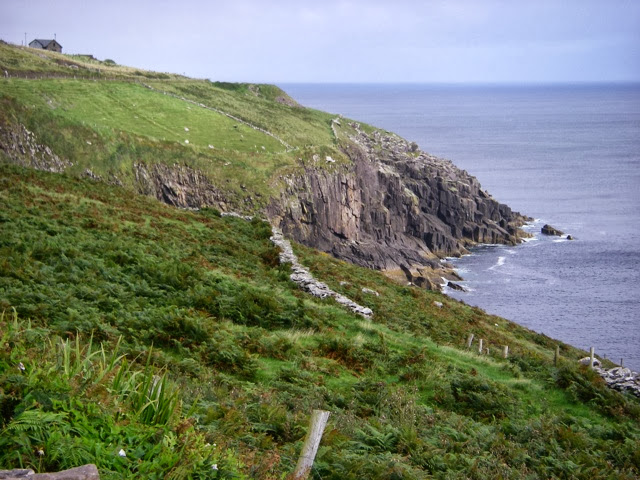Dingle is one of several peninsulas on Ireland's west coast. It, and the larger peninsula just south of it, the Ring of Kerry, are, by most reports, two of the most scenic in Ireland. We only had time to do one, and chose the smaller of the two, the Dingle. We heard a lot about the traffic, and the narrow roads, and the joys of meeting tour buses on the narrow roads. Maybe because it was rainy, or late in the season, but the traffic, except right around the town of Dingle, wasn't bad. We found parking right away.
The town of Dingle is your typical quaint, pretty combination tourist town and working fishing village. And it was crowded. It was hard to walk down the street. So we decided to take a coastal walk.
Access to these traditional footpaths must be granted and they are well marked where they meet roads, though not necessarily so well within the private property. We were taking one of these walks in Scotland one time, with a set of directions, and fortunately, the farmer came out of his barn to direct us. There is a walk around the Dingle Peninsula known as the Dingle Way. The coastal walk we took is part of that and was well used and well defined.We drove around the peninsula on a more or less counterclockwise route, starting along the southern side and cutting across at one point to the northern side. Here's some of what we saw:
Also, incredibly ancient buildings. Below, a behive hut (or clochaun). Construction of beehives date from the 11th century...though they were also constructed as late as the 19th century.

Narrow roads...

Fred trying to find a path less travelled, down from the Beehives. (The path up was straight up!)
More vistas...
We drove across the Conor Pass, the highest pass in Ireland (1496 ft). The roads were narrower, and the vistas more incredible, though I didn't take many pictures between looking at the view and throwing my hands up to ward off the oncoming traffic. Buses and lorries are warned to turn around before getting to the pass. I did take this one as we neared the pass:
We were literally in the clouds...
The roads at the pass were barely wide enough for our car. Fortunately, the opposing cars, and there were some, were canny enough to spot us well before we spotted them and use the few available pulls offs to allow us to pass. As we got down to the valley, we found a different impediment.
And then, with mixed feelings, we made our way back to Dublin, stopping for lunch in the pretty tourist town of Adare. It has a castle, churches, a nice river walk and thatched cottages.
Next adventure: Goodwood.



















No comments:
Post a Comment